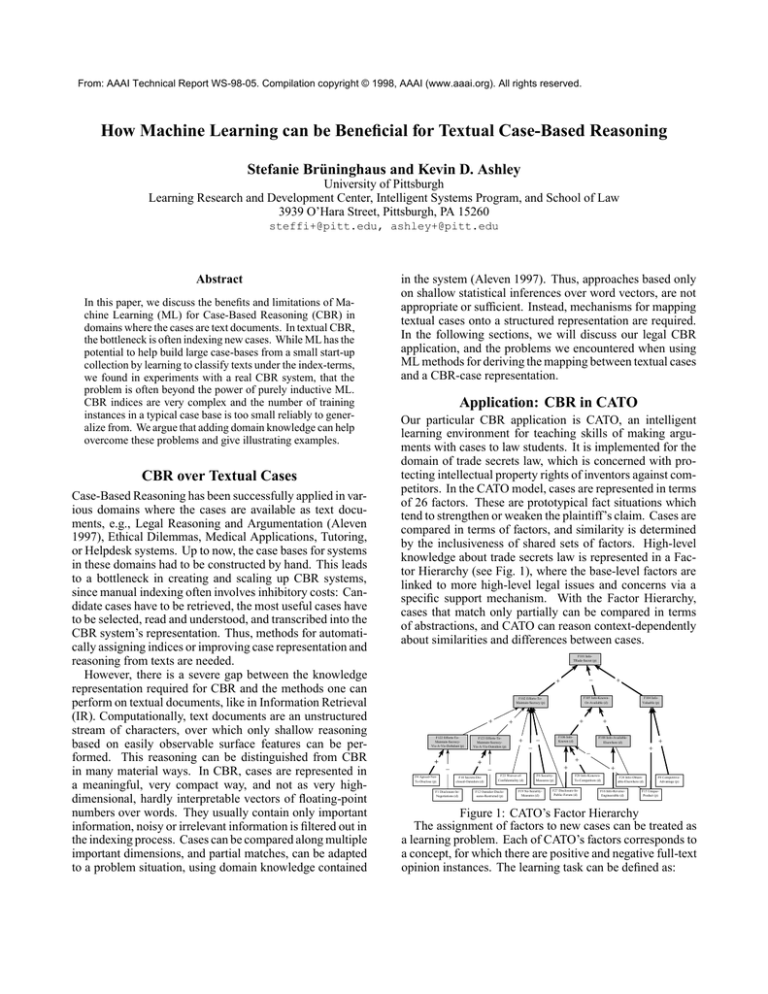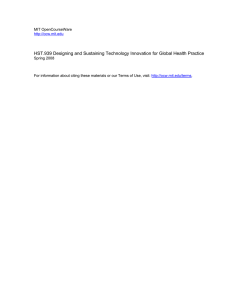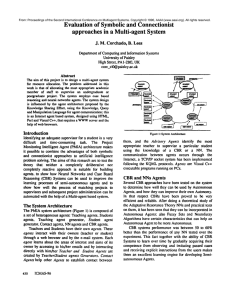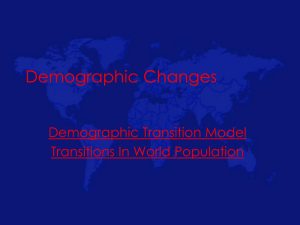
From: AAAI Technical Report WS-98-05. Compilation copyright © 1998, AAAI (www.aaai.org). All rights reserved.
How Machine Learning can be Beneficial for Textual Case-Based Reasoning
Stefanie Brüninghaus and Kevin D. Ashley
University of Pittsburgh
Learning Research and Development Center, Intelligent Systems Program, and School of Law
3939 O’Hara Street, Pittsburgh, PA 15260
steffi+@pitt.edu, ashley+@pitt.edu
Abstract
In this paper, we discuss the benefits and limitations of Machine Learning (ML) for Case-Based Reasoning (CBR) in
domains where the cases are text documents. In textual CBR,
the bottleneck is often indexing new cases. While ML has the
potential to help build large case-bases from a small start-up
collection by learning to classify texts under the index-terms,
we found in experiments with a real CBR system, that the
problem is often beyond the power of purely inductive ML.
CBR indices are very complex and the number of training
instances in a typical case base is too small reliably to generalize from. We argue that adding domain knowledge can help
overcome these problems and give illustrating examples.
CBR over Textual Cases
Case-Based Reasoning has been successfully applied in various domains where the cases are available as text documents, e.g., Legal Reasoning and Argumentation (Aleven
1997), Ethical Dilemmas, Medical Applications, Tutoring,
or Helpdesk systems. Up to now, the case bases for systems
in these domains had to be constructed by hand. This leads
to a bottleneck in creating and scaling up CBR systems,
since manual indexing often involves inhibitory costs: Candidate cases have to be retrieved, the most useful cases have
to be selected, read and understood, and transcribed into the
CBR system’s representation. Thus, methods for automatically assigning indices or improving case representation and
reasoning from texts are needed.
However, there is a severe gap between the knowledge
representation required for CBR and the methods one can
perform on textual documents, like in Information Retrieval
(IR). Computationally, text documents are an unstructured
stream of characters, over which only shallow reasoning
based on easily observable surface features can be performed. This reasoning can be distinguished from CBR
in many material ways. In CBR, cases are represented in
a meaningful, very compact way, and not as very highdimensional, hardly interpretable vectors of floating-point
numbers over words. They usually contain only important
information, noisy or irrelevant information is filtered out in
the indexing process. Cases can be compared along multiple
important dimensions, and partial matches, can be adapted
to a problem situation, using domain knowledge contained
in the system (Aleven 1997). Thus, approaches based only
on shallow statistical inferences over word vectors, are not
appropriate or sufficient. Instead, mechanisms for mapping
textual cases onto a structured representation are required.
In the following sections, we will discuss our legal CBR
application, and the problems we encountered when using
ML methods for deriving the mapping between textual cases
and a CBR-case representation.
Application: CBR in CATO
Our particular CBR application is CATO, an intelligent
learning environment for teaching skills of making arguments with cases to law students. It is implemented for the
domain of trade secrets law, which is concerned with protecting intellectual property rights of inventors against competitors. In the CATO model, cases are represented in terms
of 26 factors. These are prototypical fact situations which
tend to strengthen or weaken the plaintiff’s claim. Cases are
compared in terms of factors, and similarity is determined
by the inclusiveness of shared sets of factors. High-level
knowledge about trade secrets law is represented in a Factor Hierarchy (see Fig. 1), where the base-level factors are
linked to more high-level legal issues and concerns via a
specific support mechanism. With the Factor Hierarchy,
cases that match only partially can be compared in terms
of abstractions, and CATO can reason context-dependently
about similarities and differences between cases.
F101 InfoTRade-Secret (p)
+
F122 Efforts-ToMaintain-SecrecyVis-A-Vis-Defndant (p)
F105 Info-KnownOr-Available (d)
+
F4 Agreed-NotTo-Disclose (p)
+
−
F10 Secrets-Disclosed-Outsiders (d)
F1 Disclosure-InNegotiations (d)
+
+
F123 Efforts-ToMaintain-SecrecyVis-A-Vis-Outsiders (p)
+
−
−
+
F23 Waiver-ofConfidentiality (d)
F6 SecurityMeasures (p)
F19 No-SecurityMeasures (d)
F104 InfoValuable (p)
+
F106 InfoKnown (d)
−
F12 Outsider-Disclosures-Restricted (p)
+
−
+
F102 Efforts-ToMaintain-Secrecy (p)
F108 Info-AvailableElsewhere (d)
+
+
+
F20 Info-KonownTo-Competitors (d)
F27 Disclosure-InPublic-Forum (d)
+
−
F24 Info-Obtainable-Elsewhere (d)
F16 Info-ReverseEngineerable (d)
F8 CompetitiveAdvantage (p)
F15 UniqueProduct (p)
Figure 1: CATO’s Factor Hierarchy
The assignment of factors to new cases can be treated as
a learning problem. Each of CATO’s factors corresponds to
a concept, for which there are positive and negative full-text
opinion instances. The learning task can be defined as:
Accuracy
1
TFIDF
Libbow
"Always No"
0.9
0.8
0.7
0.6
0.5
0.4
Random
0.3
f6
f1
f4
f18 f15
f21 f16
f7
f10 f11 f19
f20 f27
f2
f8
f12 f13 f24
f5
f17
f3
f14 f26 f23
f22 f25
Figure 2: Results of experiments
Exponentiated Gradient
Random-Strategy
Winnow
Libbow-Probabilistic
Libbow-Naivebayes
Default-Strategy
TFIDF-Prototype
For each of CATO’s factors:
Given a set of labeled full-text legal opinions,
Learn a classifier which determines for a previously unseen
opinion, whether the factor applies or not.
The classifiers for the individual factors are not equally
difficult to learn. For some, we have as few as five positive
instances in the Case Database, while others apply in almost half of the cases. Clearly, the factors with few positive
instances are harder to induce. The factors also relate to
distinct real-world situations of different character. For instance, f4, Non-Disclosure Agreement, is usually described
in a more uniform way than f6, Security Measures. F6 captures a much wider variety of situations, and therefore, it is
easier to derive a classifier for cases related to f4.
In order to bring the texts in a feature/value representation
computationally accessible by an ML algorithm, we treated
the texts as bag-of-words. All punctuation and numbers,
including citations of other cases were filtered out. After
stemming, we removed stop-words and very rare terms.
Terms included single words, and adjacent pairs of non
stop-words. For term weighting, we used tfidf. We did not
consider any semantic information.
For the experiments, we implemented Rocchio, TFIDF
(Joachims 1996), Winnow, Weighted Majority (Blum 1995),
Exponentiated Gradient and Widrow-Hoff (Lewis et al.
1996), and ran the Naive Bayes classifier from the Libbow/Rainbow (McCallum 1997).
In order to assess performance, we decided to use accuracy as measure. In our application, we do not have enough
cases so that the usual interpretations of precision/recall
would hold. Also, the absence of a factor can be very relevant in making legal arguments, which makes the recognition of positive and negative instances of the concepts
relevant. Hence, we used accuracy as the main criterion to
measure performance. However, for factors with few positive instances, high accuracy can be achieved by always
labeling new cases as negative. Therefore, we also consider
precision/recall, to discover this undesired behavior.
The cases in the Case Database were assigned to test
and training sets in 10-fold, randomized cross-validation
runs. Disappointingly, in the experiments, all algorithms
performed quite poorly on our data set (Brüninghaus &
Ashley 1997). The results are shown in Fig. 1, where the
accuracy is plotted over the factors, ordered by the number
of positive instances. Only Rocchio, Libbow and TFIDF, as
shown in Fig. 2, achieved acceptable results in terms of both,
accuracy and precision/recall, for the factors where we had
a relative large number of positive training instances. On all
other factors, we often observed that the algorithms could
not discover positive cases, and always labeled opinion texts
as negative, so their accuracy is pretty close to the "always
no" strategy. Depending on parameter settings, the online
learning algorithms showed basically a random behavior.
These results did not confirm our hopes raised by results
reported previously for experiments on different problems.
For a comprehensive overview and comparison of text classification experiments, see (Yang 1997). We think that for
our problem these elsewhere successful methods did not
work that well because:
The factors are very complex concepts to be learned. A
variety of circumstances and situation can influence the
presence of a factor, and the information can be in multiple passages within the text. Sometimes, the evidence
for a factor can be indirect. E.g., it is considered to be
improper means (a factor favoring plaintiff in CATO),
if defendant searches plaintiff’s garbage. The reasoning
underlying this factor assignment is very hard to capture
in existing text classification systems without any background or semantic knowledge.
CATO’s Case Database of 150 cases is magnitudes
smaller than collections like the Reuters newswire stories or the Medline data (Yang 1997). Even so, it is
fairly large for a CBR system, tremendous time and effort went into it. It is unrealistic to hope for a case-base
of a size comparable to the Reuters collection with thousands cases for a real CBR application, so methods that
can generalize reliably from small case-bases have to be
found.
Suggestions
In spite of these discouraging preliminary results, we believe
ML can help overcome the indexing bottleneck. Rather
than improving upon purely inductive learning methods, we
think that integrating available background knowledge is
the most promising way to improve performance. With few
exceptions (notably (Koller & Sahami 1997)), background
knowledge has not been used. The learning methods have
been generic and domain-independent. CBR is application
specific, knowledge about the domain and the use of cases
is captured in case representation, similarity measure and
adaptation mechanisms. In CATO, this knowledge is represented in the Factor Hierarchy (see Fig. 1). We have worked
out a set of hypotheses concerning in what ways this knowledge can be employed to overcome the difficulties described
above.
To illustrate our ideas, we will focus on an example
from CATO’s case database. In Peggy Lawton, an employee of a food company resigned after discovering his employer’s secret cookie recipe. When he sold cookies baked
with an identical recipe, his former employer sued him for
trade secret misappropriation. In CATO’s Case Database,
this is represented by factors F6 (Security-Measures), F15
(Unique-Product) and F18 (Identical-Products).
HYPOTHESIS I A knowledge-rich representation of the
meaning of terms used will improve the learning process and enhance the effectiveness of a classifier.
Typically, documents are represented in IR and ML by
splitting the text into words, and taking those as tokens.
However, this approach neglects the specialized language
used in an area of discourse, and the meaning inherently
assigned with technical terms. The highest weighted terms
in Peggy Lawton’s document vector would be more relevant for a cookbook than for a legal application: kitchen
cooki chocolatchip chocolat hogan hogie hogiebear recip
chip cookie chipcooki lawton wolf ingredient bak.
tf/idf term weighting assigns high weights to terms that allow identifying this document within the collection, thereby
overemphasizing words not useful for assigning factors.
We believe that identifying domain specific concepts in
the document text, e.g., using a concept dictionary, can help
more reliably to determine what the document is about by
focusing ML, matching and ranking algorithms on the more
relevant input tokens.
In an experiment, we limited the vocabulary manually,
by removing all tokens irrelevant for trade secrets law, and
ran the algorithms listed above. Similarly, we collected the
West Legal Publisher’s keynotes related to trade secrets law,
and extracted the tokens from them, as described above.
The keynote system has for every case a set of manually
assigned abstract indices and short descriptions. Although
this reference system is fairly general, and not useful for
CBR, it greatly facilitates legal research. When the ML
algorithms were only given a limited set of feature/value
pairs, performance was somewhat improved. In particular
for those factors with relatively many positive instances,
we observed higher precision using either strategy, while
accuracy and recall remained constant.
HYPOTHESIS II Decomposing the problem by first determining which broader index applies to a case, and
then refining the indexing decreases the complexity of
the learning task.
Another technique potentially useful is to decompose the
problem into less complex subproblems by assigning issues
first, and then use this as input to subsequent classifiers
which identify more specific factors presented in the text.
Intuitively, it is easier to decide which general issues a case
involves than assigning the more detailed factors. Once
issues have been identified, the Factor Hierarchy’s relations
of issues to factors can be used to focus learning on particular
factors, reducing the hypothesis space.
Initial experiments suggest that learning a classifier for
deciding which issues apply in a case is still not as reliable as
we would hope, but the algorithms did considerably better
than on the base-level factors.
This idea is similar to the hierarchical text classification
suggested in (Koller & Sahami 1997). There, evidence
was presented how a hierarchical classification scheme can
increase performance, and at the same time decrease the
number of attributes necessary to represent a document.
HYPOTHESIS III Relations among factors and issues
in the Factor Hierarchy can enhance performance by
supporting predictions of the likelihood that a factor applies in situations where training instances are scarce.
In order to compensate for the small number of instances
for some of the factors, we intend to employ heuristics
based on the meaning of factors and on their relationships
expressed in the Factor Hierarchy. Based on either semantic or empirical grounds, one may infer that certain factors
naturally occur together (or not). The Factor Hierarchy expresses semantic relations among factors via more abstract
parent concepts (i.e., issues and other high-level factors),
which can provide confirming evidence for a factor in a text
and to test the credibility of an assignment of factors.
Consider, for instance, F23, Waiver-Of-Confidentiality,
which applies to only six cases in the database. The concept
is very hard to find, since it can involve diverse fact situations. It would be much easier to train a classifier to identify
factors F1, Disclosure-In-Negotiations, or F21, Knew-InfoConfidential, which apply in many more cases. F23 has
some useful relationships with these easier-to-learn factors.
There would rarely be a waiver of confidentiality without a
disclosure in negotiations. It would also be unlikely to find
a waiver of confidentiality in a case where there is a nondisclosure agreement (represented by F4) or knowledge that
information is confidential. Our expectations about these
relationships can be expressed probabilistically, and then
used with Bayes’ Law to help assess whether F23 is in fact
present: E(F 1jF 23) 7! high; E(F 4jF 23) 7! low.
The knowledge about the relations among factors represented in CATO’s Factor Hierarchy can also be used to check
the factors assigned by the system for consistency and detect incorrect classifications. Moreover, if it is possible to
determine from an (Information Extraction-like) analysis of
the text which side won, plaintiff or defendant, a system
can also reason about whether the assigned factors are consistent with the result. If only pro-defendant factors were
found, but plaintiff won, the factor assignment is suspect.
HYPOTHESIS IV Spotting quotations of statutory texts
in an opinion should help identify applicable issues.
In legal opinion texts, the courts refer to the relevant
statutes or restatement commentaries to provide a justification for their decision. Spotting these quotations is evidence
for the issue raised. The following quote of the (First) Restatement of Torts x 757 can be found in Motorola:
(a) substantial element of secrecy must exist, so that, except
by the use of improper means, there would be difficulty in
acquiring the information. ... Matters of public knowledge
... cannot be appropriated by one as his secret.
This code section is related to high-level factor F120
(Info-Legitimately-Obtained-Or-Obtainable), in CATO’s
Factor Hierarchy. Supporting evidence for F120 is highlevel factor F105 Info-Is-Known-Or-Available (“general
knowledge”), while Questionable-Means (F111), referred
to as “improper” above, blocks this conclusion. From the
quote in Motorola one may expect that these abstract factors
are related to the issues discussed in the text of the opinion.
Factors:
F101
F102
F104
F4 F5 F6 F27 F15
Dynamics
F4 F5 F6 F15
Eastern Marble
F4 Agreed-Not-To-Disclose
F5 Agreement-Not-Specific
F6 Security Measures
F15 Unique-Product
F27 Disclosure-In-Public-Forum
Figure 3: Citations and High-Level Factors in Peggy Lawton
HYPOTHESIS V Accounting for document structure can
help identify relevant text segments, thus focussing the
classifier on predictive input.
Information about the structure of the text of an opinion
can be employed beneficially in identifying important and
less relevant sections. While not following a rigid format,
legal opinions do have a basic structure: first the facts of
the case are described, then the applicable law is stated and
applied to the facts, and finally, the legal consequences are
drawn. If a system can detect this structure, the information
contained in the different parts can be used more specifically. Paragraphs related to unrelated legal matters should
be ignored, they introduce irrelevant information, or noise.
HYPOTHESIS VI Identifying cases cited in an opinion
text where it is known which factors apply to the cited
case can support inferences about the issues and factors
of the opinion.
This hypothesis is fairly specific for the legal domain,
and illustrates how one can employ a model of reasoning
with cases in this domain. Knowing which factors apply to
the cases cited in an opinion is evidence for which issues
are dealt with in the citing case, since citations are made to
support the court’s decision related to an issue by comparing
the case to precedents. The information derived from cases
cited would not allow us directly to ascertain which factors
apply, but it effects our beliefs about the case, as we will
illustrate with the Peggy Lawton case.
Peggy Lawton cites ten cases, for five of which we have a
factor representation. The factors in the cases cited can be
related to abstract factors in the Factor Hierarchy. In Fig. 3,
for example, the factors in Dynamics and Eastern Marble
are related to F101 via F102 and F104. From the court’s
selection of cases to cite, we expect it was held that plaintiff’s information was a trade secret (F101), that plaintiff
took measures to maintain the secrecy of the information
(F102) and that the information was valuable (F104).
Further Proposals
We think the task of assigning factors to opinions texts is
so complicated and involves so many different aspects that
some combination of several or all of the techniques described above is most appropriate, and may help overcome
their respective inherent limitations.
Finally, we also attempt to use more detailed information. We are marking up those sentences containing the
information whether a factor applies or not. For certain
factors, we manually constructed rules similar to Construe
(Hayes 1992) to find the relevant sentences, which seems to
work fairly well. Relational learning methods (Craven et al.
1998) are a promising way to automatically infer the kind of
rules we hand-coded. It has to be shown, though, how well
they scale up to the very long and complex documents in
the legal domain. Alternatively, a case-based approach, as
used for machine translation (Brown 1996) may be helpful.
Conclusions
Research on ML for text should not only focus on statistical models for improving upon the algorithms used, but
also consider new approaches for integrating background
knowledge. ML is a very promising approach for "bootstrapping" a large textual CBR system, by taking a medium
sized case-base and induce a classifier to automatically index new texts. However, cases and their representation are
often very complex, and the number of training instances
in a typical CBR system is too small, so that purely inductive learning algorithms are not sufficient. We presented a
set of hypotheses and some initial experimental evidence
how adding background knowledge have the potential to be
useful for overcoming these problems.
References
Aleven, V. 1997. Teaching Case-Based Argumentation
through a Model and Examples. Ph.D. Dissertation, University of Pittsburgh, Intelligent Systems Program.
Blum, A. 1995. Empirical Support for Winnow and
Weighted-Majority based algorithms. In Proc. of the 12th
International Conference on Machine Learning.
Brown, R. 1996. Example-Based Machine Translation in
the Pangloss System. In Proccedings of the 16th International Conference on Computational Linguistics.
Brüninghaus, S., and Ashley, K. 1997. Using Machine
Learning for Assigning Indices to Textual Cases. In Proc.
of the 2nd International Conference on CBR.
Craven, M.; DiPasquo, D.; Freitag, D.; McCallum, A.;
Mitchell, T.; Nigam, K.; and Slattery, S. 1998. Learning to
Extract Symbolic Knowledge from the World Wide Web.
To appear in: Proc. of the 15th National Conference on
Artificial Intelligence.
Hayes, P. 1992. High-Volume Text Processing Using
Domain-Specific Techniques. In Jacobs, P., ed., Intelligent
Text-Based Systems. Hillsdale, NJ: Lawrence Earlbaum.
Joachims, T. 1996. A Probabilistic Analysis of the Rochio
Algorithm with TFIDF for Text Categorization. Technical
report, Carnegie Mellon University. CMU-CS-96-118.
Koller, D., and Sahami, M. 1997. Hierarchically classifying documents using very few words. In Proc. of the 14th
International Conference on Machine Learning.
Lewis, D.; Shapire, R.; Callan, J.; and Papka, R. 1996.
Training Algorithms for Linear Text Classifiers. In Proc.
of the 19th Annual International ACM SIGIR Conference.
McCallum, A. 1997. Libbow/rainbow text-classification
software package. available from http://www.cs.cmu.edu/
afs/cs/project/theo-11/www/naive-bayes.html.
Yang, Y. 1997. An Evaluation of Statistical Approaches
to Text Categorization. Technical report, Carnegie Mellon
University, Pittsburgh, PA. CMU-CS-97-102.





